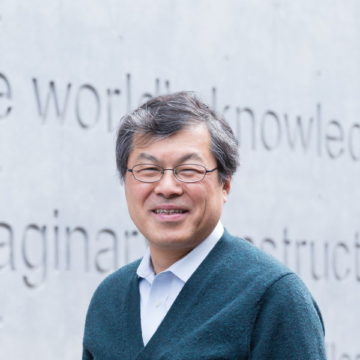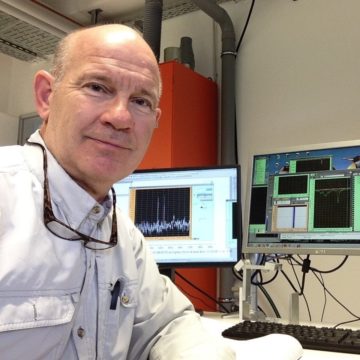Materials/Devices
Advanced Laser Spectroscopy on Highly Functional Molecular systems
Research Summary
Development and analysis of highly functional molecular systems such as supramolecules and biofunctional molecules are at the frontier of chemistry and material science research. This international collaboration focuses on molecular recognition in biological systems (Fujii, Ishiuchi, Lisy, Dopfer, Zehnacker-Rentien and Xantheas), excited state hydrogen and proton transfer in large molecular systems (Fujii, Miyazaki, Ishiuchi and Jouvet) and solvent migration dynamics in molecular clusters (Fujii, Miyazaki and Dopfer). Using a combination of advanced laser spectroscopy and high-level computational chemistry, we aim to reveal the mechanisms underlying the superior functions of these molecular systems.
- Bottom-up approach to molecular recognition in biological systems
It is known that molecular recognition regulates biological functions. Examples of such ‘Lock & key’ relationships include the pairing of nucleotide bases in DNA (A-T and C-G) and the binding of neurotransmitters such as adrenaline with receptors in neural signaling. However, biological molecules are flexible and can take various conformations, and we don’t yet have a good understanding of how this flexibility is compatible with ‘Lock & key’ recognition. For example, X-ray structural analysis have elucidated the structure of the beta2-adrenaline receptor when it binds adrenaline, but we can’t explain why similar molecules such as noradrenaline and dopamine are not recognized. We are addressing this deficit in our understanding using a unique “bottom-up” approach based on local interactions at the recognition pocket. By this approach, we can isolate partial peptides of a recognition pocket, using it to form complexes with conventional and unconventional partner molecules, such as adrenaline and dopamine. The structure of the complex can then be probed by IR spectroscopy coupled with an electrospray-cold ion trap mass spectrometer. Structural changes associated with binding between a conventional ligand and unconventional molecules can be therefore visualized, allowing an understanding of the recognition mechanism in terms of intermolecular interactions. We have demonstrated this bottom-up approach to study the recognition mechanism of beta2-adrenaline receptor. The bottom-up approach have elucidated that even penta-peptide, which is a subset of the recognition pocket, can distinguish ligands equivalently to the receptor itself. In this project, we will apply the bottom-up approach to receptor-ligand systems (Ishiuchi, Zehnacker-Rentien, Dopfer, Xantheas and Fujii) and ion recognition (Ishiuchi, Lisy, Xantheas and Fujii), as well as to the structural probe of intrinsically disordered proteins (Ishiuchi and Fujii). High level theoretical calculations will also be applied to assign complete spectra to molecules (Xantheas and Ishiuchi). This approach will reveal a mechanism of molecular recognition at the molecular level, and provides new possibilities such as fast initial screening of potential drugs, advanced data for quantum chemical drug design and new functional supramolecules. - Excited state hydrogen and proton transfer dynamics in large molecular systems
Hydrogen- and proton-transfer reactions play important roles in chemistry and photochemistry. In particular, excited-state hydrogen transfer (ESHT) in aromatic acids has become an important new principle in photochemistry and related fields. This concept was proposed at the end of 20th century by Jouvet (U Aix-Marseille and TokyoTech WRHI) and has been further established by our spectroscopic evidence (Miyazaki, Ishiuchi and Fujii, TokyoTech). In this collaboration, the mechanism of ESHT is being explored by picosecond time-resolved near-IR and IR spectroscopy (Miyazaki and Fujii) and quantum chemical calculations for excited states (Jouvet). Particularly, the hidden role of proton transfer in ESHT will be discussed. - Solvent migration dynamics in clusters
Solute-solvent interactions are fundamental in chemistry and biology as these interactions strongly affect solution dynamics. A clear-cut interpretation of interactions in solution is difficult due to non-interacting molecules in the surrounding environment. The international collaboration established as part of this project has been uncovering a clear mechanism of solvent migration dynamics based on the unique combination of picosecond time-resolved three-color IR spectroscopy (Miyazaki and Fujii) and electron-impact IR photodissociation spectroscopy (Dopfer). Solvation dynamics at the molecular level will be further investigated, having broad implications for solution chemistry, biology and related research fields.
PEOPLE
-

CharacterizationMaterials/DevicesMolecules Polymer
Otto Dopfer
Specially Appointed Professor
-

CharacterizationMaterials/DevicesMolecules Polymer
Masaaki Fujii
Professor
-

CharacterizationMaterials/DevicesMolecules Polymer
James M. Lisy
Specially Appointed Professor
-

CharacterizationMaterials/DevicesMolecules Polymer
Shun-ichi Ishiuchi
Professor
-

Materials/DevicesMolecules PolymerTheory・Design
Sotiris Xantheas
Specially Appointed Professor
-

CharacterizationMaterials/DevicesMolecules Polymer
Anne Zehnacker-Rentien
Specially Appointed Professor
